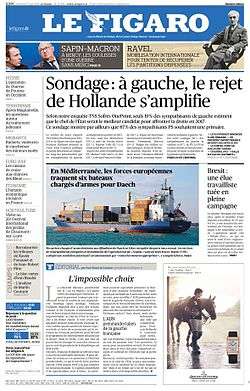Le Figaro
 | |
|
Front page of November 22, 2015 | |
| Type | Daily newspaper |
|---|---|
| Format | Berliner |
| Owner(s) | Dassault Group |
| Editor | Alexis Brézet |
| Founded | 15 January 1826 |
| Political alignment |
(in 1995:) Gaullism[1] (in 1995:) Liberal conservatism[1] |
| Language | French |
| Headquarters | Paris |
| Country | France |
| Circulation | 313,010[2] |
| ISSN | 0182-5852 |
| Website |
www |
Le Figaro (French pronunciation: [lə fiɡaʁo]) is a French daily morning newspaper founded in 1826 and published in Paris.[3] The oldest national daily in France, Le Figaro is one of the two French newspapers of record, along with Le Monde, and is one of the most widely respected newspapers in the world.[3]
With its center-right editorial line, Le Figaro is the second-largest national newspaper in France after Le Parisien and before Le Monde, although some regional papers have larger circulations. In 2012, the paper had an average circulation of 330,952 copies per issue.[4] The paper is published in the berliner format, switching from a broadsheet in 2009.
The newspaper is owned by Le Figaro Group, whose publications include TV Magazine and Evene. The company's chairman is Serge Dassault, whose Dassault Group has controlled the paper since 2004.[5]
History
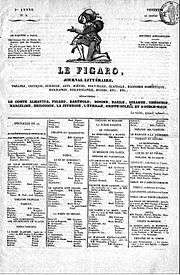
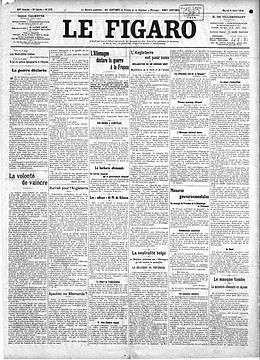
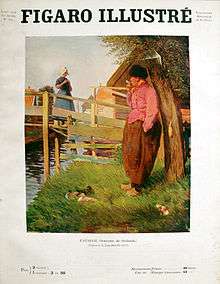
Le Figaro was founded as a satirical weekly in 1826,[6][7] taking its name and motto from Le Mariage de Figaro, the 1778 play by Pierre Beaumarchais that poked fun at privilege. Its motto, from Figaro's monologue in the play's final act, is "Sans la liberté de blâmer, il n'est point d'éloge flatteur" ("Without the freedom to criticise, there is no true praise"). In 1833, editor Nestor Roqueplan fought a duel with a Colonel Gallois, who was offended by an article in Le Figaro, and was wounded but recovered.[8] Albert Wolff, Émile Zola, Alphonse Karr and Jules Claretie were among the paper's early contributors. It was published somewhat irregularly until 1854, when it was taken over by Hippolyte de Villemessant.
In 1866 Le Figaro became a daily newspaper.[9] Its first daily edition, that of 16 November 1866, sold 56,000 copies, having highest circulation of any newspaper in France. Its editorial line was royalist.[10]
On 16 March 1914, Gaston Calmette, the editor of Le Figaro, was assassinated by Henriette Caillaux, the wife of Finance Minister Joseph Caillaux, after he published a letter that cast serious doubt on her husband's integrity.[11] In 1922, Le Figaro was purchased by perfume millionaire François Coty.[12] Abel Faivre did cartoons for the paper.[13]
By the start of World War II, Le Figaro had become France's leading newspaper. After the war it became the voice of the upper middle class, and continues to maintain a conservative position.
In 1975, Le Figaro was bought by Robert Hersant's Socpresse. In 1999, the Carlyle Group obtained a 40% stake in the paper, which it later sold in March 2002. Since March 2004 Le Figaro has been controlled by Serge Dassault,[6] a conservative businessman and politician best known for running the aircraft manufacturer Dassault Aviation, which he inherited from his father, its founder, Marcel Dassault (1892–1986). Dassault owns 80% of the paper.[6]
In 2006, Le Figaro was banned in Egypt and Tunisia for publishing articles allegedly insulting Islam.[14][15]
Le Figaro switched to Berliner format in 2009.[16] The paper has published The New York Times International Weekly on Friday since 2009, an 8-page supplement featuring a selection of articles from The New York Times translated into French. In 2010, Lefigaro.fr created a section called Le Figaro in English,[17] which provides the global English-speaking community with daily original or translated content from Le Figaro’s website. The section ended in 2012.[18]
Logo
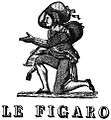 Logo during the 1820s
Logo during the 1820s Logo since the 1920s
Logo since the 1920s
Editorial stance and controversies
Le Figaro has traditionally held a conservative editorial stance, becoming the voice of the French upper and middle classes.[5]
The newspaper's ownership by Serge Dassault has been a source of controversy in terms of conflict-of-interest, as Dassault also owns a major military supplier and has served in political positions from the Union for a Popular Movement party. His son Olivier Dassault is a member of the French National Assembly.[19] Dassault has remarked in an interview in 2004 on the public radio station France Inter that "newspapers must promulgate healthy ideas" and that "left-wing ideas are not healthy ideas."[20]
In February 2012, a general assembly of the newspaper's journalists adopted a motion accusing the paper's managing editor, Étienne Mougeotte, of having made Le Figaro into the "bulletin" of the governing party, the Union for a Popular Movement, of the government and of President Nicolas Sarkozy. They requested more pluralism and "honesty" and accused the paper of one-sided political reporting. Mougeotte had previously said that Le Figaro would do nothing to embarrass the government and the right.[21][22][23] Mougeotte publicly replied: "Our editorial line pleases our readers as it is, it works. I don't see why I should change it. [...] We are a right-wing newspaper and we express it clearly, by the way. Our readers know it, our journalists too. There's nothing new to that!"[24]
Circulation history
In the period of 1995–96, the paper had a circulation of 391,533 copies, behind Le Parisien's 451,159 copies.[4]
| Year | 1999 | 2000 | 2001 | 2002 | 2003 | 2004 | 2005 | 2006 | 2007 | 2008 | 2009 | 2010 | 2011 | 2012 |
|---|---|---|---|---|---|---|---|---|---|---|---|---|---|---|
| Circulation | 366,690 | 360,909 | 366,529 | 369,108 | 369,706 | 365,083 | 337,118 | 332,818 | 338,618 | 330,482 | 323,991 | 325,509 | 329,367 | 330,952 |
See also
References
- 1 2 Raymond Kuh, The Media in France. Routledge, London and New York, 1995. Retrieved 4 September 2016.
- ↑ "Le Figaro media kit 2015 v3" (PDF). September 2015. Retrieved 5 February 2016.
- 1 2 Le Figaro (French Newspaper), Encyclopædia Britannica
- 1 2 Media Policy: Convergence, Concentration & Commerce. SAGE Publications. 24 September 1998. p. 10. ISBN 978-1-4462-6524-6. Retrieved 3 February 2014.
- 1 2 The press in France, BBC News
- 1 2 3 "The press in France". BBC. 11 November 2006. Retrieved 22 November 2014.
- ↑ "Media Landscape Media Claims" (PDF). European Social Survey. May 2014. Retrieved 12 January 2015.
- ↑ Millingen, J.G. (2004). The History of Dueling Including Narratives of the Most Remarkable Encounters.
- ↑ "Historical development of the media in France" (PDF). McGraw-Hill Education. Retrieved 24 February 2015.
- ↑ Alan Grubb, The Politics of Pessimism: Albert de Broglie and Conservative Politics in the Early Third Republic
- ↑ Sarah Sissmann and Christophe Barbier, "Une épouse outragée", L'Express, 30 August 2004. Retrieved 27 January 2007.
- ↑ Janet Flanner (3 May 1930),"Perfume and Politics", The New Yorker. Republished 7 May 2005. Retrieved 27 January 2007.
- ↑ "Deposit Your Gold for France. Gold Fights for Victory". World Digital Library. 1915. Retrieved 26 October 2013.
- ↑ "The impact of blasphemy laws on human Rights" (Policy Brief). Freedom House. Retrieved 29 September 2013.
- ↑ "Tunisia, Egypt ban newspaper editions on controversy over pope's comments". CPJ. New York. 27 September 2006. Retrieved 29 September 2013.
- ↑ "Le Figaro". Euro Topics. Retrieved 25 February 2015.
- ↑ "Mon Figaro - Cercle - Le Figaro in English - articles". Le Figaro. Retrieved 5 July 2012.
- ↑ "Mon Figaro - This Week's Top Stories from France". Le Figaro. 26 April 2012. Retrieved 5 July 2012.
- ↑ "Dassault se sépare d'Yves de Chaisemartin", Le Figaro, 1 October 2004. Retrieved 27 January 2007.
- ↑ "M. Dassault veut une presse aux « idées saines »", Le Monde, 12 December 2004. Retrieved 27 January 2007.
- ↑ ""Le Figaro" n'est pas "le bulletin d'un parti"", Le Monde, 9 February 2012
- ↑ "La question du jour. "Le Figaro" est-il un journal d'opinion ou un "bulletin" de l'UMP?", Le Nouvel Observateur, 10 February 2012
- ↑ "Présidentielle : les journalistes du Figaro réclament un journal plus « honnête »", Rue89, 9 February 2012
- ↑ ""Le Figaro" : Mougeotte répond aux critiques de ses journalistes", Le Nouvel Observateur, 10 February 2012
Further reading
- Merrill, John C. and Harold A. Fisher. The world's great dailies: profiles of fifty newspapers (1980) pp 124–29
External links
| Wikimedia Commons has media related to Le Figaro. |
- Le Figaro website (French)
- Le Figaro digital archives from 1826 to 1942 in Gallica, the digital library of the BnF
